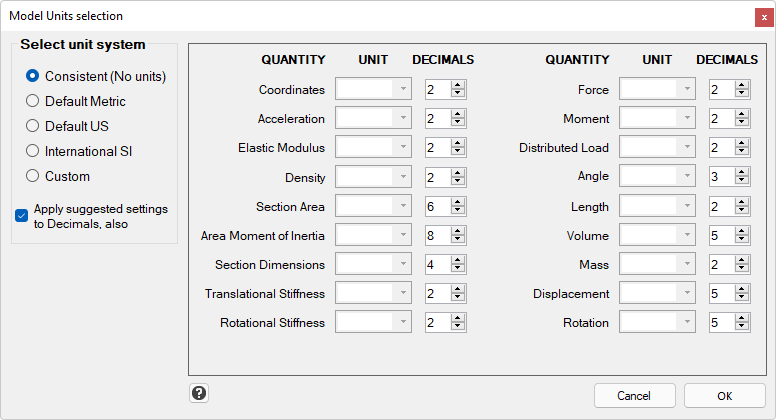
Before starting to define any model in the program, you need to select a System of Units to use. EngiLab Frame.2D supports various Systems of Units:
Default Metric
Default US
International SI
EngiLab strongly recommends the use of "EngiLab Units" software for any unit conversions needed. EngiLab Units is a free but powerful unit conversion program that is available for download at www.engilab.com. EngiLab Units 2022 (v3.5) supports 715 units in 22 unit categories, including distance, acceleration, pressure (stress) and others. All units needed in EngiLab Frame.2D are supported by EngiLab Units.

The Pre-defined Systems of Units are standard and cannot be changed. They are based on commonly used unit systems around the world.
The Custom System is fully customizable by the user.
If you click the "Units" button in the Toolbar, you get the Units form. The screenshot below depicts the Consistent System of Units. This system is special and is explained in detail in the Section Consistent Units

Consistent System of Units
The pre-defined Systems of Units are standard and cannot be changed. The Custom system is fully customizable by the user.
There are 18 types of units used in the program. The various Units and their use, are explained in detail in the following figure:
QUANTITY |
USER INPUT |
PROGRAM / ANALYSIS OUTPUT |
Coordinates |
X, Y Node Coordinates |
|
Acceleration |
X, Y Model Acceleration |
|
Elastic Modulus |
Material Elastic Modulus |
|
Density |
Material Density |
|
Section Area |
Section Area |
|
Area Moment of Inertia |
Section Area Moment of Inertia |
|
Section Dimensions |
Section Dimensions (in the Section Properties Calculator, used to define a Section). |
|
Translational Stiffness |
KX, KY Spring Stiffness |
|
Rotational Stiffness |
KZ Spring Stiffness |
|
Force |
FX, FY Nodal Load |
Element End Force (Axial and Shear Force), Support Reaction Force, Sum of Forces |
Moment |
MZ Nodal Load |
Sum of Moments |
Distributed Load |
fXi, fXj, fYi, fYj Elemental Load |
Body (Acceleration) Load on Elements |
Angle |
Polar Coordinates in Nodal Loads (used to define a Nodal Load). |
Element Orientation Angle |
Length |
Element Length |
|
Volume |
Element Volume |
|
Mass |
Element Mass |
|
Displacement |
Node Displacement |
|
Rotation |
Node Rotation |
Note that some units are used only for Model input data (for example, the Elastic Modulus unit), while other units are used for both inputs and outputs (for example, the Force unit). Others are used only for outputs (for example, the Displacement unit).
Note that Angle and Rotation are separate units in EngiLab Frame.2D. The Angle unit is used to show the Element Orientation Angle, while the Rotation unit is used for the rotational degree of freedom of the Nodes (Node Rotation in Nodal Displacements).